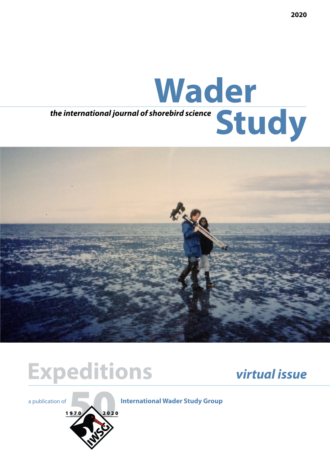Expeditions

Cover: Theunis Piersma and Patricia Gonzalez, San Antonio Oeste, Argentina, 1995 (photo by Petra de Goeij)
Knowledge on population sizes and migratory connectivity are essential for conservation and, in order to gather these data, wader enthusiasts have always followed the birds to remote places to count, mark and re-sight them. When Wader Study Group Bulletin (WSGB) was first published in 1970, it became the obvious outlet to share the results of such global expeditions. In this first Virtual Issue, we put together a selection of expedition reports that have been published in WSGB and in Wader Study throughout the last fifty years, highlighting several key reports from each decade.
In the very first issue of WSGB, Mike Pienkowski and Peter Stanley described two expeditions to Iceland (Pienkowski & Stanley 1970), which aimed to catch and mark Red Knots Calidris canutus on the way to and from Greenland. The success of those trips sparked another expedition in the following year, 1971, with the aim of continuing the previous work but also to extend it to other wader species (Morrison 1971). In that same year, there was an expedition to Morocco and a summary of the results was published in 1972 (Pienkowski 1972). Years later, during the boreal winter of 1976–1977, an expedition to the southern tip of the East-Atlantic flyway, in Namibia (although prior to its independence in February 1990 and so referred to as South Africa), resulted in 1,084 shorebirds ringed and over 51,000 individuals counted. Interestingly, in Walvis Lagoon, they found approximately 2,000 Chestnut-banded Plovers Charadrius pallidus, at the time the largest number ever recorded (Summers 1977).
With the turn of the decade, during an expedition to the Parc National du Banc d’Arguin, Piersma et al. (1980) counted over 2 million waders. And in 1981, Olivier Fournier and William Dick faced difficulties in surveying the vast area of mudflats and mangroves of the Bijagós Archipelago but were convinced of its ‘outstanding international importance’ (Fournier & Dick 1981). The 1980s saw many more expeditions, including to Tunisia, where a complete census of the waterbirds of the Gulf of Gabès was undertaken, birds were caught and marked, and data on the benthic infauna collected (van Dijk et al. 1984). Several expeditions also visited other flyways, for example, work in Suriname collecting information on the relationship between the biomass of benthic infauna and the number of foraging birds (Spaans & Swennen 1982). In 1985, part of the Sarawak coast on the island of Borneo (Malaysia) was surveyed and the waders counted and mapped (Edwards & Parish 1988). And at the end of the decade, the wetlands of Barr al Hikman and Ghubbat al Hashish in Oman were visited and almost 200,000 waders counted, cementing the area’s importance for shorebirds (Green et al. 1994).
Expeditions continued in the 1990s to northwest Australia, where 83 people from 16 countries got together to catch and mark over 8,000 waders in seven weeks (Minton et al. 1997), and to Siberia, to search for the Slender-billed Curlew Numenius tenuirostris (Boere & Yurlov 1998). In the early 2000s, several expeditions visited Argentina, to study the Red Knot population in Tierra del Fuego (Baker et al. 2005) and, more recently, Christoph Himmel reported on wader counts in southern Azerbaijan, at one of the last under-surveyed areas of the Western Palearctic (Himmel 2020). These various expeditions throughout the last five decades have gathered valuable information about the population sizes, migration routes and distributions of bird species globally – these papers give you a taste of the sort of information collected and how that has changed in the last 50 years.
Wader Catching in Iceland, Summer 1970 Mike Pienkowski & Peter Stanley Volume 1. 1970. Cambridge Iceland Expedition 1971 Guy Morrison Volume 3. 1971. The Result of the University of East Anglia Expedition to Morocco 1971 Mike Pienkowski Volume 6. 1972. Western Cape Wader Study Group: South West African Expedition 1976-1977 Ron Summers Volume 20. 1977. A Wader Expedition to Mauritania Theunis Piersma, Meinte Engelmoer, Wibe Altenburg & Ron Mes Volume 29. 1980. Preliminary Survey of the Archipel Des Bijagos, Guinea-Bissau Olivier Fournier & William Dick Volume 31. 1981. The 1980 Dutch Mini-Expedition to Suriname A. L. Spaans & C. Swennen Volume 34. 1982. Waders of the Gulf of Gabès, Tunisia, January to March 1984 Arend J. van Dijk, Klaas van Dijk, Lieuwe J. Dijksen, Tom M. van Spanje & Eddy Wymenga Volume 41. 1984. The Distribution of Migratory Waders in South-West Sarawak Phillip J. Edwards & Duncan Parish Volume 54. 1988. Counts of Shorebirds at Barr Al Hikman and Ghubbat Al Hashish, Oman, Winter 1989-90 Mick Green, Mike McGrady, Steve Newton & John Uttley Volume 72. 1994. The N.W. Australia Wader Study Expedition in March and April 1996 Clive Minton, Humphrey Sitters & Roz Jessop Volume 82. 1997. In Search of the Slender-Billed Curlew Numenius Tenuirostris Preliminary Results of an Expedition to Wetlands and Waterbirds of the Baraba and Karasuk Steppe in the South of West Siberia, Russian Federation, 17 May - 22 June 1997 Gerard C. Boere & Alexsandr K. Yurlov Volume 82. 1998. Annual international expeditions to study the Red Knot population in Rio Grande, Tierra del Fuego, 2000–2004. Allan J. Baker, Patricia M. Gonzalez, Luis Benegas, Susan Rice, Verónica L. D’amico, Monica Abril, Adrian Farmer & Mark Peck Volume 107. 2005. Research on waders in southern Azerbaijan, one of the last under-surveyed areas of the Western Palearctic Christoph Himmel Volume 127(1). 2020.
